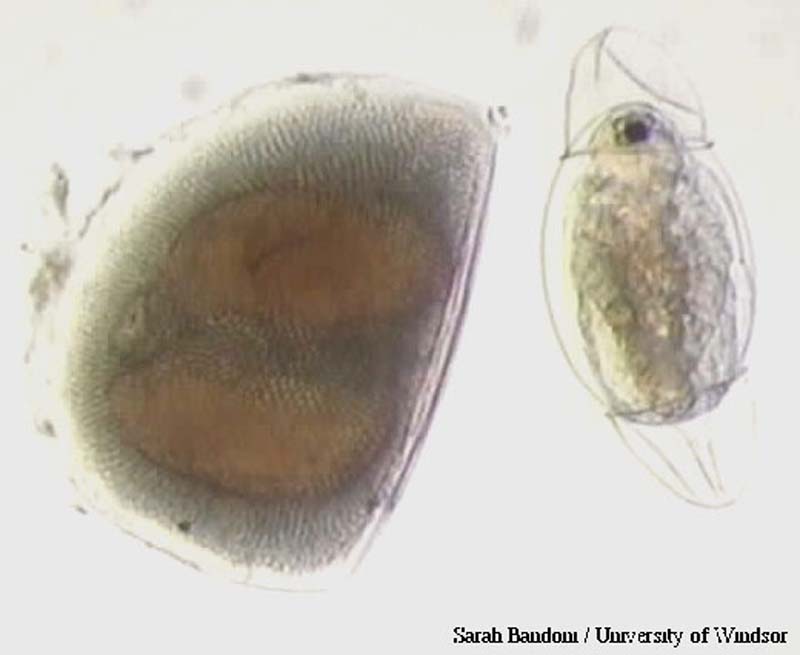Ephippial on:
[Wikipedia]
[Google]
[Amazon]

 Ephippia (singular: ephippium) are winter or dry-season eggs of the various species of small crustacean in the order
Ephippia (singular: ephippium) are winter or dry-season eggs of the various species of small crustacean in the order

Cladocera
The Diplostraca or Cladocera, commonly known as water fleas, are a superorder of small crustaceans that feed on microscopic chunks of organic matter (excluding some predatory forms).
Over 1000 species have been recognised so far, with many more ...
(within the Branchiopoda
Branchiopoda is a class of crustaceans. It comprises fairy shrimp, clam shrimp, Diplostraca (or Cladocera), Notostraca and the Devonian ''Lepidocaris''. They are mostly small, freshwater animals that feed on plankton and detritus.
Description
M ...
); they are provided with an extra shell layer, which preserves and protects the resting stages inside from harsh environmental conditions until the more favorable times, such as spring, when the reproductive cycle is able to take place once again. Ephippia are part of the back of a mother carrying them until they are fully developed. After molting, the ephippium stays in the water, or in the soil of dried puddles, small ponds, and vernal pool
Vernal pools, also called vernal ponds or ephemeral pools, are seasonal pools of water that provide habitat for distinctive plants and animals. They are considered to be a distinctive type of wetland usually devoid of fish, and thus allow the safe ...
s. The resting stages are often called eggs, but are in fact embryos with arrested development. Ephippia can rest for many years before the embryo resumes development upon an appropriate hatching stimulus.
See also
* ''Bythotrephes longimanus
''Bythotrephes longimanus'' (also ''Bythotrephes cederstroemi''), or the spiny water flea, is a planktonic crustacean less than long. It is native to fresh waters of Northern Europe and Asia, but has been accidentally introduced and widely distr ...
'' (invasive species)
* ''Cercopagis pengoi
''Cercopagis pengoi'', or the fishhook waterflea, is a species of planktonic cladoceran crustaceans that is native in the brackish fringes of the Black Sea and the Caspian Sea. In recent decades it has spread as an invasive species to some freshw ...
'' (invasive species)
* ''Daphnia
''Daphnia'' is a genus of small planktonic crustaceans, in length. ''Daphnia'' are members of the order Anomopoda, and are one of the several small aquatic crustaceans commonly called water fleas because their saltatory swimming style resembl ...
** ''Daphnia longispina
''Daphnia longispina'' is a planktonic crustacean of the family Daphniidae, a cladoceran freshwater water flea. It is native to Eurasia. ''D. longispina'' is similar in size and sometimes confused with the often sympatric '' D. pulex'' (a very ...
''
** ''Daphnia lumholtzi
''Daphnia lumholtzi'' is a species of small, invasive water fleas that originates in the tropical and subtropical lakes of Africa, Asia, and Australia. As an invasive species, ''Daphnia lumholtzi'' disrupts aquatic habitats by spreading throughou ...
'' (invasive species)
** ''Daphnia magna
''Daphnia magna'' is a small planktonic crustacean (adult length 1.5–5.0 mm) that belongs to the subclass Phyllopoda.
Description
''D. magna'' is a typical water flea of the genus ''Daphnia''. The females reach up to 5 mm in size, ...
'' (large species)
** ''Daphnia pulex
''Daphnia pulex'' is the most common species of water flea. It has a cosmopolitan distribution: the species is found throughout the Americas, Europe, and Australia. It is a model species, and was the first crustacean to have its genome sequenced. ...
'' (small, most common)
* ''Moina
''Moina'' is a genus of crustaceans within the family Moinidae. The genus was first described by W. Baird in 1850. They are referred to as water fleas, but are related to the much larger ''Daphnia magna'' and the larger ''Daphnia pulex''. This ...
'' (smallest)
References
Further reading
* * * *External links
Branchiopoda Fishkeeping Freshwater crustaceans {{Branchiopoda